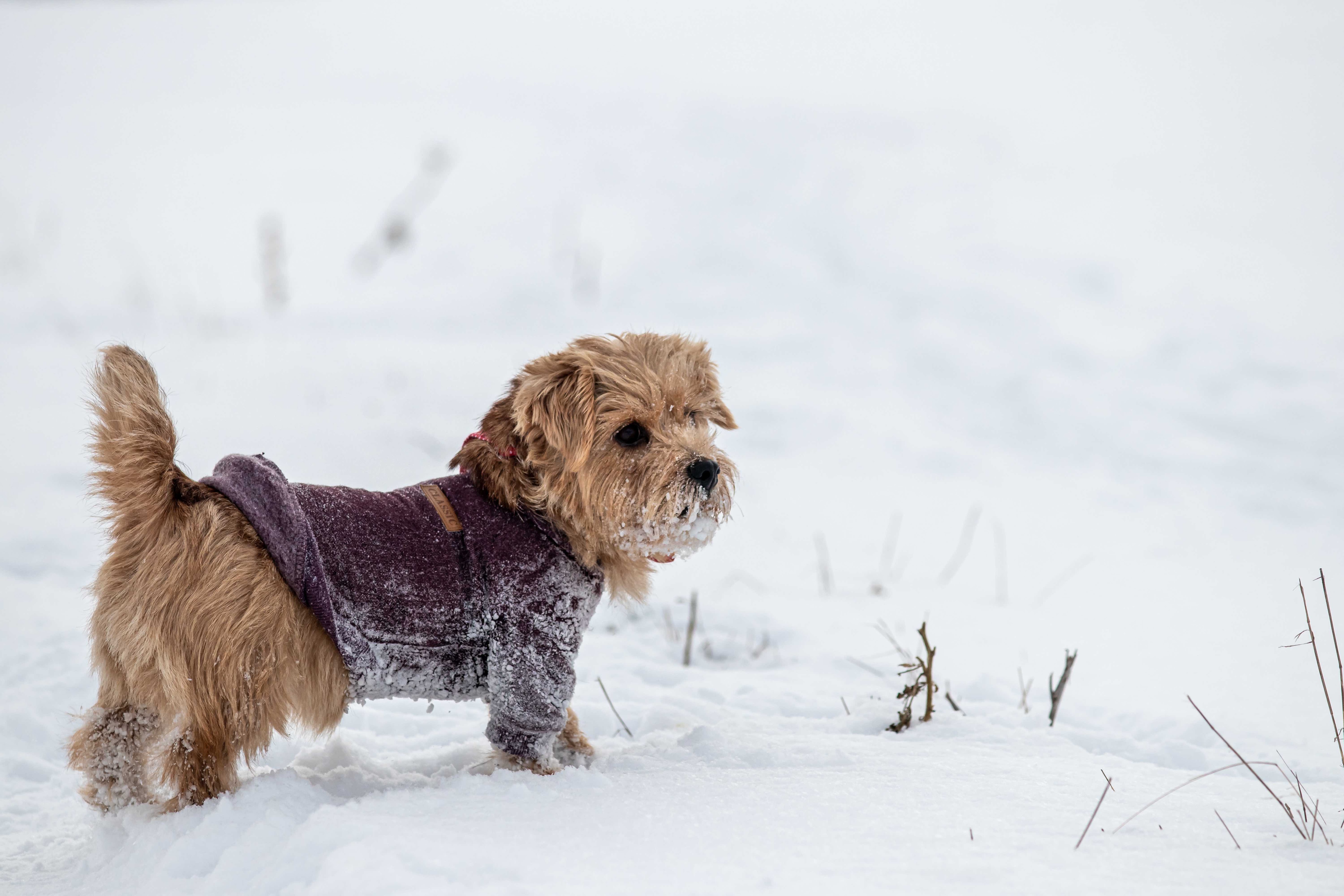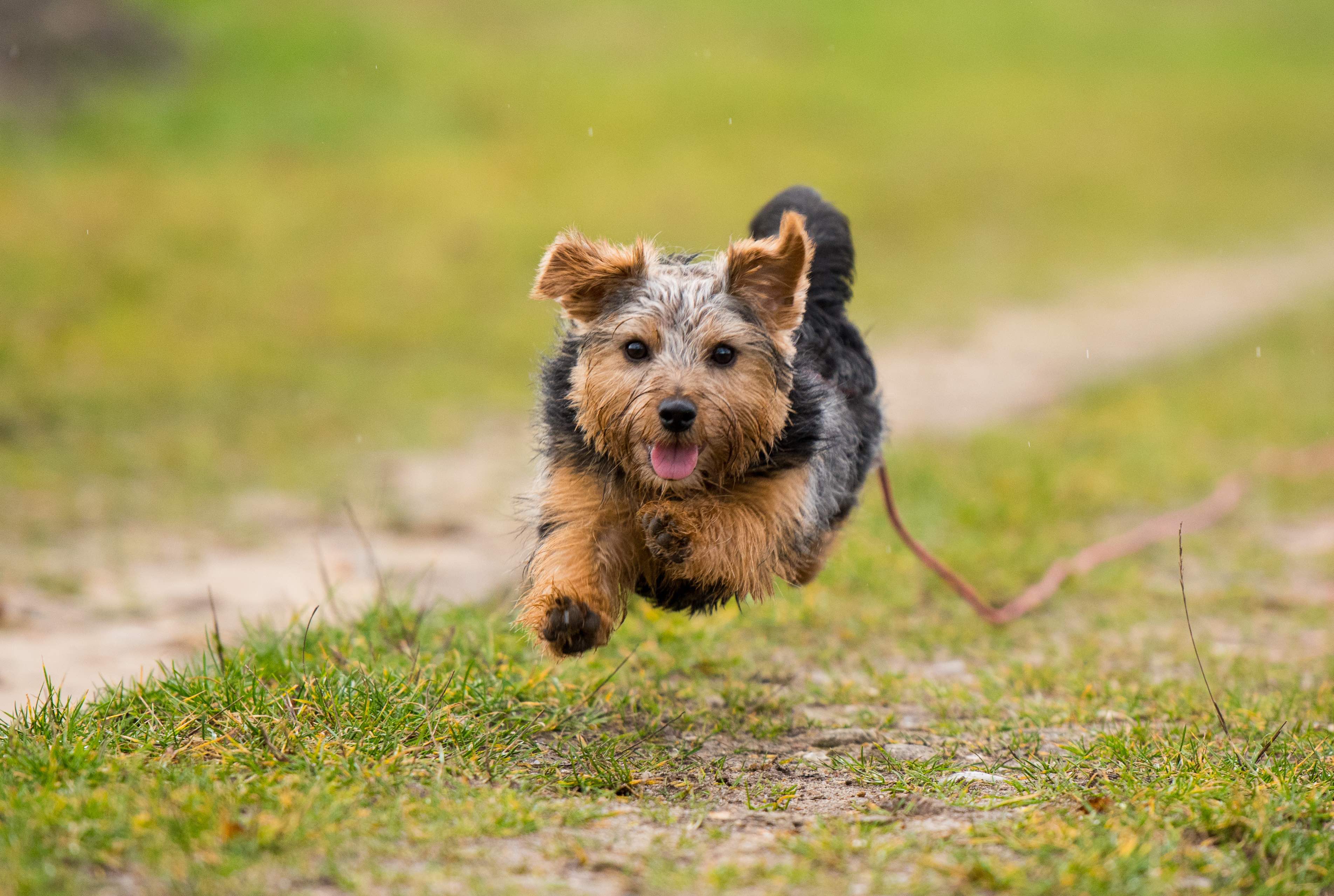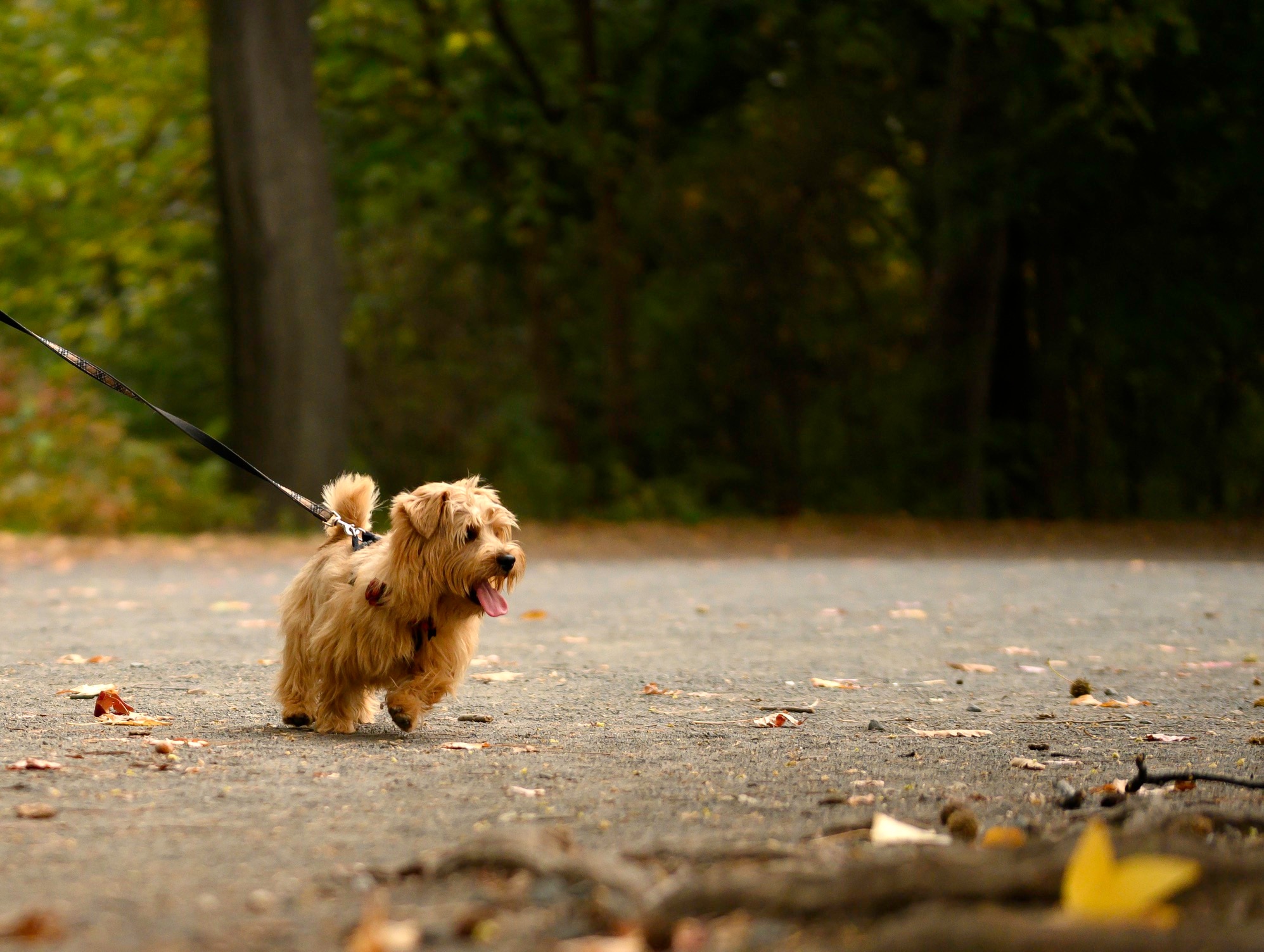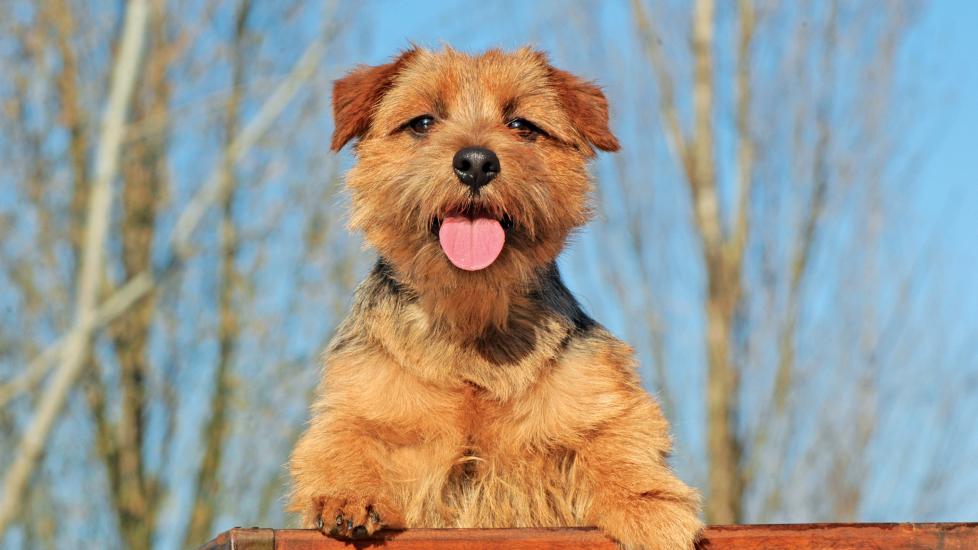Norfolk Terrier
The Norfolk Terrier is a little, energetic terrier breed that’s both a loving and affectionate companion and a fearless athlete. They were developed in late 1800s England to hunt rats and foxes, according to the Norfolk Terrier Club (NTC). This hardy little dog loves to run and play, and then will curl up in their pet parent’s lap for cuddles.
Along with being a warmhearted companion, Norfolk Terriers are also one of the smallest working terriers, standing no more than 10 inches at the shoulder and weighing just 11–12 pounds.
Caring for a Norfolk Terrier
The Norfolk Terrier is an affectionate and spunky little dog that makes a wonderful pet. They have perky personalities and love adventure but will settle down for cuddles. Most individuals are very patient with children, though kids should always be taught how to interact with small dogs. They have moderate grooming needs.
Norfolk Terrier Health Issues

The average Norfolk Terrier lifespan is 12–16 years—longer than the average dog. They are generally hardy, healthy dogs, but Norfolks are predisposed to a few medical conditions that are more common in the breed.
Myxomatous Mitral Valve Disease
One of the most serious conditions that can occur in Norfolk Terriers is a form of degenerative heart disease called myxomatous mitral valve disease (MMVD). In this condition, the heart allows blood to flow back in the wrong direction. This can create a heart murmur, heard as a whooshing sound when the heart is listened to with a stethoscope.
Over time, this abnormal blood flow often causes enlargement of the heart and may lead to congestive heart failure. Some dogs with MMVD never develop severe disease, while others may need intensive care.
A physical exam by a veterinarian should be performed at least once a year. If they hear a heart murmur, your vet may recommend chest X-rays to evaluate the size of the heart and the vessels around it. In many cases, the vet may recommend a referral to a veterinary cardiologist for an echocardiogram (an ultrasound of the heart). Medications may be prescribed to slow progression of MMVD and/or to treat congestive heart failure.
Dental Disease
Dental disease is one of the most common conditions seen in dogs as they age, especially in small breeds like the Norfolk Terrier. Bacterial tartar and plaque lead to inflammation of the tissues around the teeth, and eventually to tooth and bone decay. The best way to prevent dental disease is with daily toothbrushing using a pet-specific toothpaste.
Routine dental cleanings under anesthesia are recommended for Norfolk Terriers to evaluate the mouth, remove plaque and tartar, polish teeth to prevent future buildup, and treat or extract teeth that are significantly unhealthy.
Patellar Luxation
The patella (kneecap) is a small bone that normally sits in a groove within the femur at the knee. In dogs with patellar luxation, the patella moves (or luxates) outside of its designated groove when the knee is flexed.
This inappropriate movement can cause discomfort and may lead to osteoarthritis. Maintaining a lean body condition helps prevent osteoarthritis associated with patellar luxation. In mild cases, anti-inflammatory medications and joint supplements may be sufficient to control pain. In cases of severe luxation, your dog might need surgery to secure the kneecap.
Hip Dysplasia
Hip dysplasia is a genetic disease in which the hip joint doesn’t conform properly and becomes too loose. This then causes the cartilage and bone to wear down, and degenerative joint disease and arthritis may develop.
When pain is present, non-steroidal anti-inflammatory drugs (NSAIDs) are frequently prescribed to reduce inflammation and pain. Your vet may recommend surgery if the pain from hip dysplasia cannot be managed.
What To Feed a Norfolk Terrier

Norfolk Terriers should eat a food that meets the nutritional standards set by the Association of American Feed Control Officials (AAFCO). The food must also be formulated for their current life stage. Talk to your veterinarian to help you pick the best dog food.
Norfolk Terrier puppies should be fed a diet formulated specifically for puppies or designated for “all life stages.” For adults, dental-focused diets may be recommended by your veterinarian to help prevent dental disease, a common concern for the Norfolks.
How To Feed a Norfolk Terrier
This breed does best with two measured feedings per day. Norfolk Terrier puppies, however, should eat three to four small meals per day on a regular schedule to help maintain stable blood sugar.
How Much Should You Feed a Norfolk Terrier?
How much a Norfolk Terrier should eat depends on a few factors, including:
-
Size
-
Metabolism
-
Neuter status
-
Health history
-
Activity level and lifestyle
The best way to determine portion sizes is to talk with your veterinarian, who can calculate specific caloric needs.
Nutritional Tips for Norfolk Terriers
Norfolk Terriers require a balance of carbohydrates, proteins, and fats to stay healthy. They may benefit from the addition of omega-3 fatty acids into their diet, which can be found in skin and joint supplements, fish oil, and even in some specially formulated dog foods. These fatty acids act as natural anti-inflammatories that help to support the skin, coat, kidneys, joints, and heart.
Behavior and Training Tips for Norfolk Terriers
Norfolk Terrier Personality and Temperament
The Norfolk Terrier is a fun, energetic, and sweet breed that’s up for just about any activity. Norfolks like to be active and should have their energy expended through playtime and long walks before being left alone for extended periods.
They are known for their patience and love of children, so Norfolk Terriers can make great family dogs. But, as with any dog, supervision around children and other animals is always important.
Norfolk Terrier Behavior
True to their terrier nature, the Norfolk Terrier has a lot of energy that needs to be exhausted to keep them out of trouble. If your Norfolk grows bored, they may bark excessively, dig in the yard, or become destructive.
Many Norfolk Terriers have a strong prey drive, which means they do not always live in harmony with cats or other small animals. There’s a crucial socialization period when a Norfolk Terrier puppy is under 12 weeks old, during which they should be exposed to new people, pets, and children. This can be accomplished in puppy classes, where age-appropriate vaccinations are required.
Norfolk Terrier Training
The Norfolk Terrier is very intelligent and bonds closely to their family. They’re eager to please their pet parents and can respond quickly to training, especially when positive reinforcement methods (such as using games, praise, and food rewards) are used.
Fun Activities for Norfolk Terriers
-
Obedience training
-
Nose work
Norfolk Terrier Grooming Guide
The Norfolk Terrier has a short, wiry double coat that has modest grooming needs. They are moderate shedders, and routine brushing is helpful to decrease the amount of fur that ends up on your floor.
Skin Care
The Norfolk Terrier should be bathed about every four to six weeks. Take care not to over-bathe them; bathing more frequently than every two weeks can strip the coat’s natural oils. For most individuals, using a gentle dog shampoo is best.
Coat Care
The Norfolk Terrier has a shaggy and wiry double coat. While they don’t shed excessively, hand stripping (a process where the fur is removed from the root instead of trimmed) is necessary a few times per year. This helps their coat retain its wiry texture and reduces the shedding that does happen, especially during their twice-yearly “coat blowing.”
Eye Care
Wiping your dog’s eyes daily with a soft, moist cloth or veterinary-approved wipe will help remove debris. The hair around their eyes should be carefully trimmed to keep it from causing irritation.
If you notice your dog squinting or developing eye discharge, a trip to the veterinarian is recommended. These can be signs of more serious eye conditions.
Ear Care
The Norfolk Terrier’s folded-over ears make them susceptible to ear infections, as moisture and debris can become trapped in the ear canal. Cleaning the ears every one or two weeks for maintenance helps prevent ear infections. If redness, odor, or debris is noted, an ear infection may be present and you should consult your veterinarian.
Considerations for Pet Parents

The Norfolk Terrier is a remarkable pet thanks to their sweet nature, playfulness, and eagerness to please. These dogs have a love for adventure and won’t be quite as happy in a sedentary household.
While they are known for their acceptance of children, young kids should be taught how to interact with small animals like the Norfolk Terrier. It’s also important to know that these dogs may have a strong prey drive thanks to their hunting ancestry, so they could have difficulty living harmoniously with smaller animals, including cats.
Norfolk Terriers have moderate home-grooming needs, but a large professional grooming budget isn’t necessary for these dogs. Regular visits to the vet, however, are crucial to check their teeth and look for signs of heart disease, especially as your Norfolk Terrier ages.
Norfolk Terrier FAQs
Are Norfolk Terriers good pets?
Norfolk Terriers are great pets that love to explore and play. They may do best in a relatively active household, but introductions with cats and other small animals need to be done properly and slowly.
Do Norfolk Terriers like to cuddle?
While the Norfolk Terrier may like to spend most of their time playing and exploring, at the end of the day they won’t hesitate to sit and cuddle in your lap.
Are Norfolk Terriers low-maintenance?
The Norfolk Terrier does not have a lot of grooming needs aside from regular brushing and a twice-yearly hand stripping. But they need a lot of activity and mental stimulation to stay out of trouble, which some may consider to be high-maintenance.
What’s the difference between Norfolk Terriers and Norwich Terriers?
Norfolk Terriers and Norwich Terriers have a lot in common but are considered two distinct breeds. Both are sturdy little terriers who were bred to hunt. They also look similar, aside from slight variations in the coat texture and ear shape: A Norwich Terrier’s ears stand straight up, while a Norfolk’s fold over.
Featured Image: Wirestock/iStock / Getty Images Plus via Getty Images
